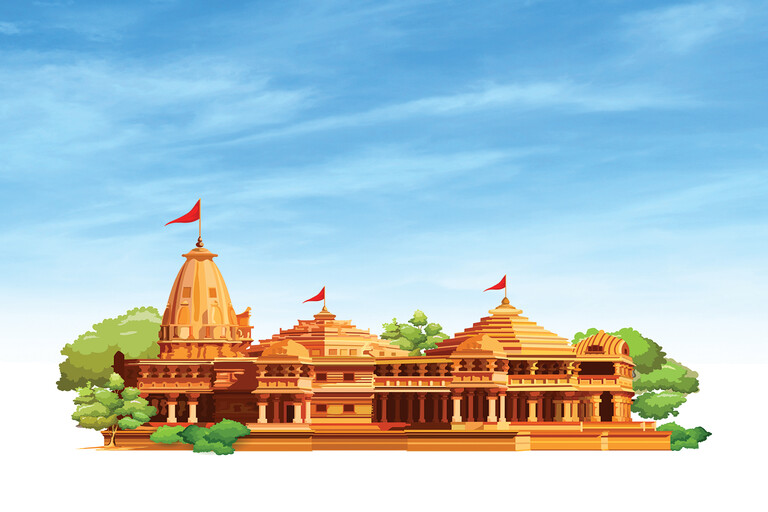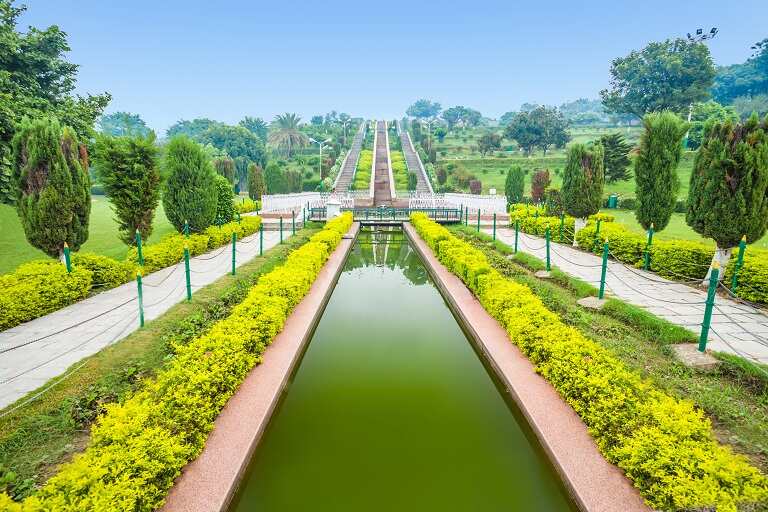
Ayodhya Darshan Guide: Unveiling the Sacred Sights of this Holy City
Table of contents
The recently inaugurated temple in Ayodhya has attracted devotees from across the world with its grandeur and spirituality. This divine sanctum, steeped in cultural richness, is a sacred site for the Hindu faith and commemorates Lord Ram’s birthplace. It follows strict rules ensuring peace, tranquillity and spiritual immersion. The temple’s visiting hours span from morning until evening, accommodating believers with different schedules. A visit to the new Ayodhya temple promises a memorable experience of serene prayer, meditation and connection to Indian culture and history.
Guide on Mandir Darshan
On January 22, 2024, the magnificent Ram Lala temple, situated in Ayodhya, was recently inaugurated by Indian Prime Minister Narendra Modi. The reopening of the historic temple, which has undergone substantial renovations, marks a significant moment for Hindu devotees all over the world.
The Ram Lala temple, dedicated to Lord Rama, is open to devotees from
- Morning- 6.30 am to 12.00 noon
- Afternoon- 2.30 pm to 10.00 pm.
The time of Ramlalla Aarti is as follows.
- Mangala Aarti- 4.30 am
- Shringaar Aarti- 6.30 to 7.00 am
- Bhog Aarti- 11.30 am
- Midday Aarti – 2.30 pm
- Evening Aarti- 6.30 pm
- Shayan Aarti- 8.30 to 9.00 pm
The devotees are suggested to arrive at the temple half an hour before the Aarti to secure a place and experience a seamless darshan. The temple is packed with devotees during weekends and auspicious Hindu festival days; therefore, it is recommended to plan the visit on weekdays for a less crowded experience.
The dress code for the temple is traditional Indian attire. Women are advised to wear sarees, suits, or lehengas, while men are suggested to wear kurta-pajama, dhoti or simple trousers and shirts. Short or revealing clothing is not considered appropriate for the sacred site.
It has become a revered spiritual destination offering ‘prasads’ such as laddoo and peda that can be purchased both offline at the temple’s counter or online through their official website.
The divine aarti can be attended by devotees by pre-booking slots. For offline bookings, one can visit the temple’s booking counter, while for online booking, one needs to register on the official website and follow the instructions for aarti booking. The platform ensures an efficient and smooth booking process. The temple administration ensures the process is seamless and hassle-free for all devotees.
While the darshan at the Ram Lala temple is free of cost, donations of any amount are welcome as they contribute to the maintenance and welfare of the temple. In the holy town of Ayodhya, the newly renovated Ram Lala temple stands as a testament to Hindu faith and devotion, drawing in countless devotees each day.
How to reach Ayodhya?
The Ram Lala temple, also known as Ram Janmabhoomi Temple, is situated in Ayodhya, a town in Uttar Pradesh, India. This city can be accessed by different modes of transportation.
By Air:
The nearest airport to reach the Ayodhya Ram Lalla Temple is the Chaudhary Charan Singh International Airport in Lucknow around 135 kilometres away. There are daily flights to Lucknow from major cities of India such as Delhi, Mumbai, Bangalore, Chennai, and Kolkata. From Lucknow, one can hire a taxi or take a bus to Ayodhya which will take approximately 3 hours.
The Central Government of India has planned a new airport in Ayodhya, expected to be operational by February 2024. It is anticipated to significantly enhance accessibility for pilgrims and tourists to the city, particularly to the iconic Ram Lalla Temple. Moreover, it is expected to contribute to the development of the entire region as well with flights from SpiceJet, The Sky and Air India Express joining in.
By Rail:
Ayodhya railway station is well connected to the main cities of India. Several trains ply from different parts of the country to Ayodhya. Some popular trains are Lucknow Passenger, Gorakhpur Express, and Howrah-Jammu Tawi Himgiri SF Express. Depending on your starting point, the time taken will vary.
By Road:
Ayodhya is well connected with the rest of Uttar Pradesh and India via a network of national and state highways. Regular bus services are available from nearby cities like Lucknow, Allahabad, Varanasi, and Gorakhpur. Private vehicles and taxis are also common modes of road transport for reaching Ayodhya. The road trip from Lucknow to Ayodhya will take you about 2-3 hours depending on the traffic conditions.
How to reach the Ram Lalla Temple once you are in Ayodhya?
To reach the Ram Lalla temple, once you reach Ayodhya, you can either take an auto-rickshaw or hire a cab as local transportation is easily available in the city. As it’s a highly frequented tourist spot, you’ll find several transportation options available. Ensure you plan your journey to make your visit to the temple smooth and enjoyable.
Where to stay in Ayodhya?
Ayodhya, the birthplace of Lord Rama, attracts thousands of tourists every year. If you plan to visit the renowned Ram Lalla Temple, finding the right accommodation should be one of your prime concerns. Here are some popular accommodation options in Ayodhya:
Ramprastha Hotel:
Situated within a radius of 3km from the Ram Lalla temple, it offers rooms at rates varying from INR 1000-2500 per night, depending upon the type of room you choose. The hotel offers all basic facilities and ensures a comfortable stay.
Krishna Palace Hotel:
It’s around 3.5 km away from the Ram Leela temple and is known for its courteous staff and clean rooms. The room tariffs range from INR 1200-1800 per night.
Tulsi Smarak Bhawan:
This budget accommodation is about 2.5 km away from the temple. You may book a room for as low as INR 600-1200 per night here.
Rishikesh Vihar Guest House:
It is located around 1.5 km away from the temple. You can avail of rooms within a budget of INR 800-1500 per night.
Options for Temple Accommodation:
Some temples also provide lodging facilities. For instance, the Bharti Bhawan Trust and Manas Bhawan provide basic accommodations at nominal prices. They are located around 1 km from the Ram Lela temple and the rates start from INR 500 per night. However, booking in advance is recommended due to the high demand.
Another temple accommodation is Shri Ram Janaki Bhawan, around 2 km from the Ram Lela temple. The accommodation provided is modest and charges vary from INR 300-800 per night.
Distance should not be much of an issue as most places in Ayodhya are easily accessible by auto-rickshaws or on foot. Lastly, always remember to cross-check the prices and facilities while booking, as they might vary according to the season and demand.
Top Temples to Visit in Ayodhya:
Listed below are the top Temples to visit while visiting Ayodhya.
Hanuman Garhi:
One of the most popular temples in Ayodhya, Hanuman Garhi is devoted to Lord Hanuman. Believed to be the location where Lord Hanuman was stationed to protect Ramkot, the temple has a fortress-like structure and houses the idol of Lord Hanuman holding Baby Ram.
Kanak Bhavan:
Another famous temple, Kanak Bhavan is believed to be a gift from Kaikeyi to Sita. Devotees believe Lord Rama and Goddess Sita dwell here. The present structure, known for its grandeur and opulence, was built by a queen of Tikamgarh in 1891.
Mani Parbat:
This ancient temple is famous for its historical significance and mythology. Once a large hill, it is now just a mound but is believed to be a fragment of a mountain that Hanuman carried from the Himalayas. The place offers a panoramic view of Ayodhya city.
Nageshwarnath Temple:
Known as the oldest temple in Ayodhya, Nageshwarnath Temple holds an important place in history. According to legend, it was built by Kush, Lord Rama’s son. It is also one of the twelve Jyotirlinga temples.
Sita ki Rasoi:
This temple is located close to Ram Janmabhoomi. Sita ki Rasoi is an interesting visit as it’s believed to be the kitchen of Sita, wife of Lord Rama. You can find models of various kitchen utensils depicting the era of Ramayana.
Dasrath Bhavan:
Another significant temple is Dasrath Bhavan, said to be the residence of King Dasharath and Queen Kaushalya, parents of Lord Rama. Here, devotees can visit and learn about the various incidents and stories related to Ramayana.
Ramkot:
The principal place of worship in Ayodhya, Ramkot attracts thousands of pilgrims each year, especially on Ram Navami. The temple provides a spiritual retreat amidst a serene ambience.
Treta Ke Thakur:
This temple stands at the site where Lord Rama is said to have performed Ashvamedha Yajna. The idols here are carved out of a single black sandstone and are a remarkable sight.
These are four religiously significant pilgrimages near the holy city of Ayodhya: Bharat Kund, Guptarghat, Makhbhoomi, and Suryakund.
Bharat Kund:
Located around 20 kilometres away from Ayodhya, Bharat Kund is believed to be the historic place where Lord Ram’s younger brother, Bharat, performed penance while he ruled Ayodhya on behalf of Ram.
Guptarghat:
Located on the banks of River Sarayu, Guptarghat is revered as the place where Lord Ram made his way into the river to return to his heavenly abode, making it a must-visit pilgrimage.
Makhbhoomi:
Considered holy in Islam, Makhbhoomi is the burial site of Sheikh Ahmad Makki, a well-known saint who migrated to Ayodhya from Mecca.
Suryakund:
A solar temple complex, Suryakund is known for its ancient Sun Temple and a kund or pond believed to have healing properties.
Events and festivals in Ayodhya:
Ayodhya, a city in Uttar Pradesh, India, is celebrated as the birthplace of Lord Rama. This holy city hosts a plethora of cultural events and festivals each year. The most prominent is Diwali, marking the return of Lord Rama to Ayodhya after 14 years of exile. The city lights up with millions of lamps, a spectacular sight called Deepotsav, to welcome Rama.
Ram Navami, the birthday of Lord Rama, is another key event celebrated with enthusiasm. During this festival, a grand procession carrying the idols of Rama, his wife Sita and brother Lakshman is carried out through the city.
Other significant festivals include the Chariot Festival and Ram Lila, a dramatic enactment of Lord Rama’s life. Shravan Jhoola Mela is a lesser-known local festival where deities are swung on ceremonial jhoolas (swings). Each festival brings with it a distinct blend of rituals, colour, joy, and fervour that beautifully reflects Ayodhya’s rich religious heritage.
Top tips when you visit in Ayodhya:
- Inside the Ram Janmabhoomi complex, which includes the renowned Ram Lalla temple, you are prohibited from carrying personal belongings such as phones, wallets, chargers, pens, and notebooks. However, free lockers are available on-site for your convenience.
- Located between the complex bases, you will find the Ram Rasoi managed by the Mahavir Mandir Trust of Amava Patna. Visitors who come to pay homage to Ram Lalla at the Ram Rasoi are provided with complimentary food upon presenting their Aadhar cards.
- Transport to Ayodhya is easily accessible from Lucknow International Airport, with taxi services available at approximately Rs 3000. Once in the city, E-buses operate throughout, and a Golf Court is also available for Rs 50 per person.
- The best time to visit Ayodhya, considering weather conditions and festivals, are the months of March, April, May, October, November, and December.
- Security is taken seriously within the complex, with a minimum of five checkpoints during your darshan at the Ram Lalla temple. You may be subjected to a security check.
- In case of medical emergencies, a medical camp is located within the Ram Mandir premises, with Shri Ram Hospital nearby for additional support.
- For further assistance, the help desk at the Ram Janmabhoomi complex can be reached at 05278, or you can contact the SHO of the Ram Janmabhoomi police station at 9454403310.
Take Away
Ayodhya, with its spiritual aura and historical significance, is a must-visit destination for those seeking a cultural and religious experience. Let Thomas Cook be your guide in creating a seamless and memorable journey through the heart of Ayodhya.
Table of contents
Trending blogs for you
 18002099100
18002099100




















